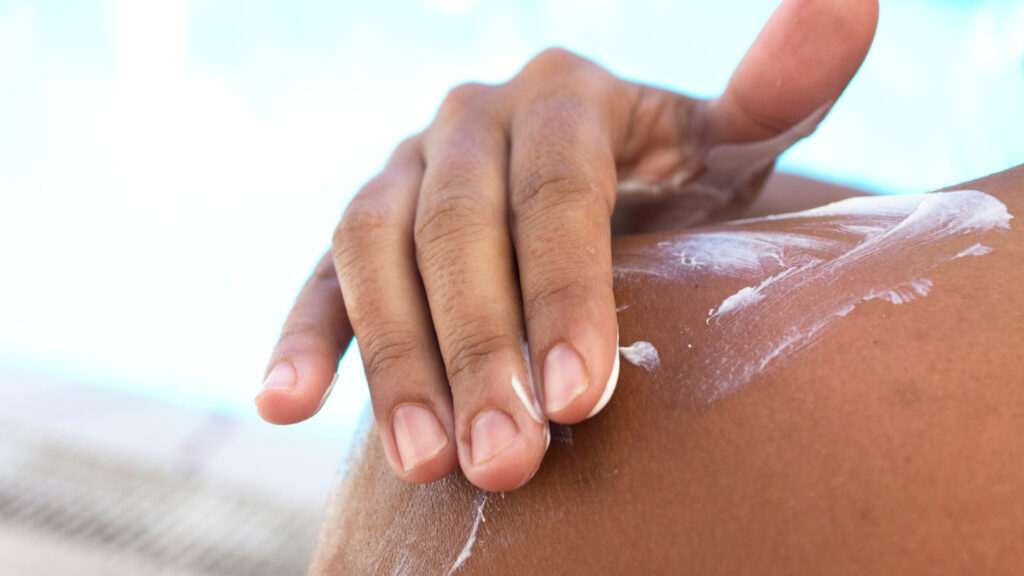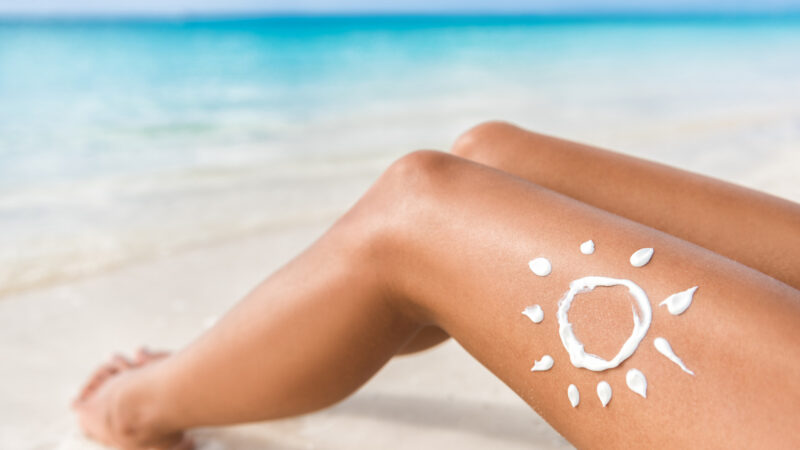Table of Contents Show
If you haven’t heard of reef-safe sunscreen yet, it’s time you do. You’ve probably heard of mineral sunscreens and chemical sunscreens.
You’ve seen lotions, sprays, and mists on the shelves at the local stores. With so many options for sunscreens, it’s hard to know what to choose.
You may want to be environmentally conscious but also provide the best protection for your skin. With reef-safe sunscreen, you can do your part to save the world’s coral reefs and protect your skin with safe ingredients.
Let’s learn what reef-safe sunscreen is and why it’s important!
What Is Reef-Safe Sunscreen?
Although there are no regulations for what “reef-safe” sunscreen means, the underlying idea is that these sunscreens are better for the well-being of coral reefs. Harmful chemicals in other types of sunscreen can damage reefs.
In fact, Hawaii passed a law that banned sunscreen products containing oxybenzone and/or octinoxate in 2018.
The bill reads, “The legislature finds that the use of chemical-based sunscreen is detrimental to the health of Hawaii’s coral reef ecosystems.
The National Ocean Service finds that the chemicals in both lotion and aerosol sunscreens can impair the growth of plants, stunt and deform animals, and contribute to the bleaching of coral.”
Sunscreen gets released into the ocean when people swim in the water. The drainage of swimming pools and showers also makes its way into the ocean via storm and wastewater.
So there has been a push in recent years for sun-seekers to turn to reef-safe sunscreen.

Is Reef-Safe Sunscreen a Scam?
Reef safety isn’t regulated at all compared to FDA-regulated attributes like broad-spectrum, water-resistance, and SPF rating.
Nothing definitively explains what these types of sunscreens can or can’t have. Therefore, much of the hype around reef-safe sunscreens is attributed to marketing.
However, reef-safe sunscreen is real. With the decline of coral reefs around the world, doing our part to protect them is essential to their existence. And you do want to avoid certain ingredients and note the quantities.
The Haereticus Environmental Laboratory (HEL) has released a list that details these harmful chemicals that pose a threat to ecosystem health. This list includes parabens, oxybenzone, octinoxate, nylon powders, any form of microplastic sphere or beads, and more.
How Do I Know If a Sunscreen Is Reef Safe?
Don’t rely on the front label that says “reef-safe” sunscreen. You must read the ingredients. Refer to the HEL List to identify any harmful chemicals that could damage coral reefs.
You also want to use micro-sized or non-nano mineral sunscreens. These lotions avoid nanoparticles which can be toxic.
It’s also a good idea to stick with lotions instead of sprays or mists. Many of these sunscreens have titanium dioxide that can also harm your health if inhaled.
What Harmful Chemicals Are in Other Sunscreens That Damage Coral Reefs?
Along with the previously mentioned harmful chemicals, other ingredients to avoid include zinc oxide, titanium dioxide, 4-methylbenzylidene camphor, para-aminobenzoic acid, triclosan, homosalate, octisalate, and butyloctyl salicylic acid.
You’ll also find sunscreens that use the Orgasol polyamide products, polyester plastic powders, nylon glitters, polyester glitters, HDI/trimethylol hexyllactone crosspolymers, polycaprolactones, and polyethylene powders or fibers.
All of these ingredients can potentially harm coral reefs, thus contributing to their demise throughout the world.
Keep in Mind:
What Are Some Examples of Reef-Safe Sunscreen?
If you want to do your part to protect coral reefs, here are three examples of reef-safe sunscreen. Remember, these sunscreens make their way into the ocean whether you swim in a local recreational pool or play in the Atlantic.
Highest Rated: Kokua Sun Care
Rated 4.5/5 stars, this Kokua Sun Care mineral sunscreen provides 80 minutes of water resistance. It also offers protection from both UVA and UVB rays. Because it goes on clear, you don’t worry about the white spots and streaks like with other sunscreens.
The active ingredient of non-nano zinc oxide provides superior protection, while the Hawaiian-grown botanicals of Hawaiian kukui nut oil, Hawaiian macadamia nut oil, Hawaiian spirulina, noni, and plumeria hydrate and moisturize your skin.
One reviewer explains, “It was really important to me that whatever sunscreen I bought was reef-safe, but some of the other options out there did not have the best reviews. This stuff is AMAZING!
A little goes a long way; it smells great, has natural ingredients, is reef safe, and IT WORKS better than ANY sunscreen I have ever tried! I’ve bought four bottles and told anyone I can about this stuff because I love it so much.”
- NON-NANO ZINC OXIDE SUNSCREEN: Our luxury high performance sunscreen provides broad spectrum protection using the...
- SKIN CARE: Defend your skin from free radicals and UV damage, while hydrating, nourishing, and moisturizing it with...
Best for Sensitive Skin: MANDA Organic Sun Paste
This organic sun paste is one of the best options for sensitive skin. It’s also very environmentally friendly with its cruelty-free and chemical-free commitment.
It provides an SPF of 50 for excellent sun protection and is made with high-quality, food-grade, all-natural, and organic ingredients. This MANDA sun paste also has non-nano zinc oxide as the active ingredient.
Other natural ingredients include all organic coconut oil, beeswax, cocoa butter, Thanaka, cacao powder, shea butter, and cinnamon oil.
A happy customer writes, “I LOVE THIS STUFF! It works well, lasts forever, and has a great smell. I use it for surfing, hiking, tennis, or any active sports outdoors.
It acts as a physical layer of protection, and I know that I am not putting untested chemicals into my body. I am stoked to find this product and will remain a loyal customer.”
- MANDA Waterproof SPF 50 sunscreen paste is designed for long days in the sun! The sun paste sits on top of your skin,...
- Our travel sized sunblock is perfect those looking for long lasting UV protection that is easy to take with you! Our...
Budget Friendly: Raw Elements Face and Body Natural Sunscreen
Many natural, organic, reef-safe products are more expensive than their less eco-friendly counterparts. But this sunscreen from Raw Elements is a great option for sunbathers on a budget.
You’ll find this product is non-GMO, titanium dioxide-free, non-nano, cruelty-free, and reef-safe. But it also works. This natural sunscreen provides broad-spectrum sun protection with an SPF of 30. It’s gentle for sensitive skin and easy to apply.
One customer titled her review “Holy Grail Sunscreen” and says, “I cannot use chemical sunscreen without breaking out, but mineral sunscreen that doesn’t dry your skin, leave a horrible white cast or leave you oily has been pretty much impossible to find.
Also, it’s always important that my products are environmentally friendly, as natural as possible, reef-safe, etc. This sunscreen has everything I’m looking for.”
- Eco-Friendly Protection: Our SPF 30 Face + Body Lotion, formulated with zinc oxide, is an organic, natural sunscreen...
- Pure and Powerful: Crafted from all-natural ingredients, including zinc oxide, our lotion provides true broad-spectrum...
Other Ways to Protect Yourself From the Sun
Protecting coral reefs is important to our planet, but protecting your skin from the sun is also important. In addition to choosing a reef-safe sunscreen, you can find other ways to protect your skin.
Use Sun-Protective Clothing
Any time you go out hiking, biking, paddling, or any other type of outdoor recreational activity, wear sun-protective clothing.
You’ll find clothing specifically designed for outdoor enthusiasts with SPF ratings. Even with long sleeves, you won’t get hot due to the material used, and you’ll protect your skin from sun damage.
Keep in Mind:
Accessories with Sunglasses and a Hat
Not only do you want to protect your arms and legs with clothing that provides a high SPF rating, but you also want to protect your eyes and head.
Wear sunglasses when outside. Cover your head with a sun-protective hat. Choose a wide-brimmed hat with a neck flap for even more protection for your face and neck.

Avoid the Sun During Peak Hours
Finally, you might think getting that perfect tan is paramount during spring or summer break, but it’s very dangerous. Avoid being in the sun during the afternoon when its rays are strongest.
Avoid being outside between 10 a.m. and 4 p.m., even in winter and at high altitudes where you don’t think you need to worry about the sun’s harmful rays. Go for an evening walk or get up early for a sunrise jog.
Protect Our Coral Reefs By Using Reef-Safe Sunscreen This Summer
Protect both your skin and our coral reefs with reef-safe sunscreen this summer. Don’t let the labels fool you. Read the ingredients used in the product.
No matter where you go swimming, harmful chemicals can wash into our water, the world’s most valuable resource. It can damage plant and animal life and even our own health. If we all do our part to save the coral reefs, we can protect our oceans for future generations.
Have you considered a reef-safe sunscreen before?
Last update on 2024-07-27 / Affiliate links / Images from Amazon Product Advertising API









